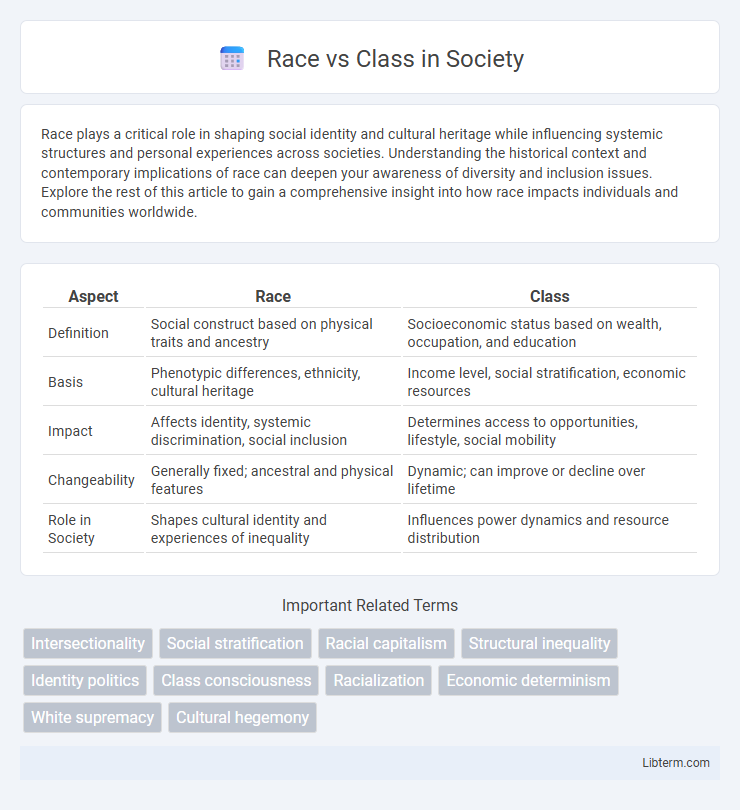Race plays a critical role in shaping social identity and cultural heritage while influencing systemic structures and personal experiences across societies. Understanding the historical context and contemporary implications of race can deepen your awareness of diversity and inclusion issues. Explore the rest of this article to gain a comprehensive insight into how race impacts individuals and communities worldwide.
Table of Comparison
| Aspect | Race | Class |
|---|---|---|
| Definition | Social construct based on physical traits and ancestry | Socioeconomic status based on wealth, occupation, and education |
| Basis | Phenotypic differences, ethnicity, cultural heritage | Income level, social stratification, economic resources |
| Impact | Affects identity, systemic discrimination, social inclusion | Determines access to opportunities, lifestyle, social mobility |
| Changeability | Generally fixed; ancestral and physical features | Dynamic; can improve or decline over lifetime |
| Role in Society | Shapes cultural identity and experiences of inequality | Influences power dynamics and resource distribution |
Understanding Race and Class: Definitions and Differences
Race refers to social categories based on physical characteristics and perceived ancestry, while class relates to socioeconomic status determined by income, education, and occupation. Understanding these distinctions is crucial for analyzing systemic inequalities, as race often intersects with class but remains an independent axis of identity and discrimination. Clarifying definitions of race and class enables more precise discussions on social stratification and policy development.
Historical Context of Race and Class Relations
The historical context of race and class relations reveals a complex interplay shaped by colonization, slavery, and industrialization, which entrenched racial hierarchies alongside economic exploitation. Racial discrimination often intersected with class oppression, as marginalized racial groups were systematically confined to lower socioeconomic statuses through policies like segregation and labor exploitation. Understanding this intersection is crucial to analyzing ongoing inequalities in wealth distribution, employment opportunities, and social mobility.
Intersectionality: Where Race and Class Meet
Race and class intersect to shape complex social identities and experiences, influencing access to resources, systemic oppression, and social mobility. Intersectionality highlights how racial discrimination compounds economic inequalities, resulting in disproportionate poverty rates among marginalized racial groups. Understanding this overlap is crucial for addressing structural barriers and promoting equitable policies that consider both racial and class dimensions.
Structural Inequality: Systems That Perpetuate Race and Class Divides
Structural inequality manifests through institutional policies and practices that systematically disadvantage marginalized racial groups and lower socioeconomic classes. Segregated education systems, discriminatory housing policies, and unequal access to healthcare reinforce cyclical poverty and racial disparities. These interconnected systems perpetuate entrenched race and class divides, limiting social mobility and equity.
Race, Class, and Economic Opportunity
Race significantly shapes economic opportunity by influencing access to education, employment, and wealth accumulation, often creating systemic barriers for marginalized racial groups. Class intersects with race, further complicating economic outcomes, as lower socioeconomic status disproportionately affects racial minorities, limiting upward mobility. Structural racism embedded in policies and institutions perpetuates economic disparities, underscoring the critical need to address race-based inequalities to achieve true economic equity.
Social Mobility: Barriers and Pathways
Race significantly influences social mobility, with systemic barriers such as racial discrimination in education, employment, and housing limiting opportunities for marginalized groups. Class shapes access to resources, social networks, and cultural capital, which are critical for upward mobility, but intersecting racial factors often exacerbate economic inequality. Policies targeting equitable education funding, anti-discrimination enforcement, and affordable housing can create pathways to reduce racial disparities in social mobility.
Education Disparities: The Role of Race and Class
Education disparities persist due to the intertwined effects of race and socioeconomic class, with marginalized racial groups often facing limited access to quality schools and resources compared to their wealthier, predominantly white counterparts. Research shows that students from low-income families experience lower academic achievement and higher dropout rates, compounded by systemic racial biases in school funding and disciplinary practices. Addressing these disparities requires policies targeting both economic inequality and racial discrimination to create equitable educational opportunities.
Representation and Media Narratives
Media narratives often shape perceptions of race and class by disproportionately representing marginalized racial groups in lower socioeconomic contexts, reinforcing stereotypes and systemic inequalities. Representation in film, television, and news frequently prioritizes racial identities over class complexities, which obscures the intersectionality and nuanced experiences of individuals facing economic hardship. Addressing these disparities requires a concerted effort to depict diverse stories that authentically capture the interplay between race and class within societal structures.
Policy Responses: Addressing Race and Class Inequities
Policy responses to race and class inequities emphasize targeted investments in education, healthcare, and affordable housing to dismantle systemic barriers disproportionately affecting marginalized racial and socioeconomic groups. Affirmative action programs and progressive tax reforms aim to reduce disparities by promoting economic mobility and equitable access to resources. Data-driven policy design prioritizes intersectional analysis to ensure that initiatives effectively address the compounded impacts of race and class on inequality.
Building Alliances for Social Justice
Building alliances for social justice requires recognizing the interconnected nature of race and class oppression, fostering solidarity across diverse communities. Effective coalition-building emphasizes shared economic struggles alongside racial justice, leveraging collective power to challenge systemic inequalities. Embracing intersectionality enhances strategic collaboration, amplifying marginalized voices and advancing equitable policy reforms.
Race Infographic

 libterm.com
libterm.com